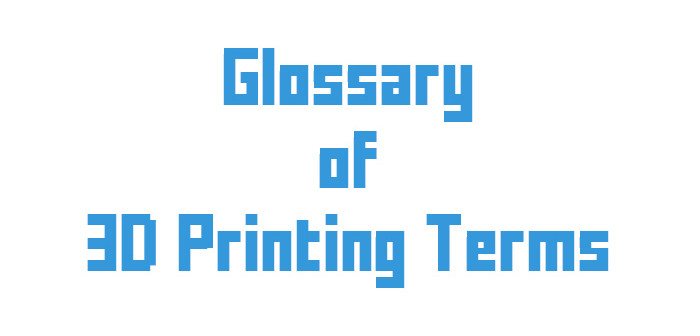| X3G – a file format read by 3D printers to print design files. |
| 3D – three-dimensional. |
| 3D Printer – an additive manufacturing machine that creates three-dimensional objects by following instructions given through a three-dimensional, digital, design file. |
| ABS – (acrylonitrile butadiene styrene) a thermoplastic filament derived from natural gas and petroleum that is tough and impact resistant. |
| Additive Manufacturing – a manufacturing process for creating objects, achieved by adding one layer of material at a time until enough layers have been stacked and fused, to complete a three-dimensional design. |
| Build Plate – See Print Bed. |
| Print Bed – the surface where the 3D manufacturing process takes place. |
| CAD – (computer-aided design) three-dimensional design created with the aid of a computer. It is from computer-aided design files that instructions for 3D printers are created. |
| Calibration – alignment of one part relative to another, such as the parallel alignment that would be found between the print bed and extrusion nozzle of a 3D printer. |
| cc/hr – (cubic centimeter per hour) See flow rate. |
| Curling – an upward contraction of extruded filament from the bottom outer edges of a print inward due to factors such as uneven heating and cooling. |
| Dual Extruder – an extruder with two nozzles that allows for printing with multiple colors, textures, and resolutions. Dual extruders also allow for simultaneous printing. |
| Extruder – the printing component of a 3D printer through which filament is heated, passed, and lain. |
| Extrusion – the process of passing the heated filament through the extruder (typically onto a print bed). |
| FDM – (fused deposition modeling) an additive manufacturing process that utilizes extrusion of filament to create three-dimensional objects by extruding a stream of filament that “traces” the shape of a design until a single layer is complete. Then, subsequent layers are added in the same way, each layer fusing with the previous, until all of the designated layers have been lain and the design is complete. |
| FFF – (fused filament fabrication) See FDM. |
| Filament – a thread of material fed into a 3D printer and extruded for fabrication. |
| Flow Rate – rate at which filament flows through the extruder (usually onto the print bed), defined as volume per time. |
| HIPS – (high-impact polystyrene) a thermoplastic filament that is soluble in limonene and sometimes used as a support material. |
| Hot End – the end of the extruder that heats up to melt the filament that will be extruded from the nozzle. |
| Iteration – the repetition of a process; used in reference to a generation, version, or edition of a 3D printer model. |
| Layer Height – the height, usually measured in microns, of a single extruded layer of filament. |
| Leveling – See calibration. |
| Lifting – See curling. |
| Micron – unit of measurement equivalent to a micrometer, often used to describe printing resolution, accuracy, and precision. |
| Nozzle – the part of the extruder containing the orifice through which heated filament exits. |
| Nozzle Diameter – refers to the size of the orifice on the nozzle. |
| Orifice – the opening in the nozzle of the extruder. |
| PLA – (polylactic acid) thermoplastic polyester filament made from plant based materials. |
| Platform – See print bed. |
| Positioning Precision – refers to how precisely the nozzle moves to each designated point in a print. |
| Print – command to begin the modeling process; a completed model. |
| Printing – the physical process of creating a three-dimensional object through fused filament fabrication. |
| Print Envelope – the total space in which 3D printing can take place, usually expressed in terms of the x, y, and z axes. |
| Prototype – a draft model used to present or test a design. |
| PVA – (polyvinyl acetate) a rubbery, water-soluble, thermoplastic filament used as a support material. |
| Rapid Prototyping – quickly fabricating a scale model using computer-aided design and 3D printing. |
| RepRap – (replicating rapid prototyper), a 3D printer that can print most or all of its own components. |
| RepRap Project – an initiative to develop 3D printers that can print most or all of their own components. |
| Resolution – See layer thickness. |
| Slicing – dividing a 3D design into layers in order to create instructions a 3D printer can follow to create an object. |
| STL – (stereolithography) file format in which computer-aided designs are stored. |
| Stepper Motor – a motor with a gear-shaped rotor that allows for very precise movement and the ability to be stopped at very precise points without creating backlash. |
| Viscosity – liquid filament’s resistance to movement by force, due to friction among adjacent particles. |
| Warping – distortion of extruded filament due to factors such as uneven heating and cooling. See curling. |
| WPC – (wood polymer composite) a filament made from wood particles and binding polymers. |
| X-Axis – axis that allows for movement from left to right and right to left. |
| XY Plane – the horizontal plane of the x and y axes. |
| Y-Axis – axis that allows for movement from front to back and back to front. |




